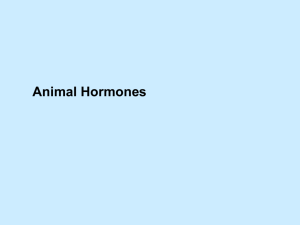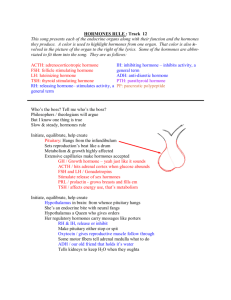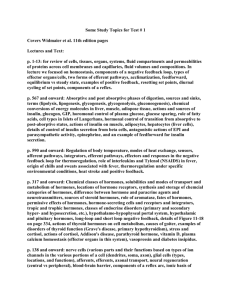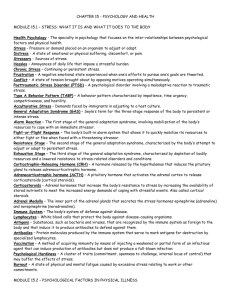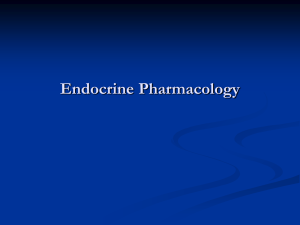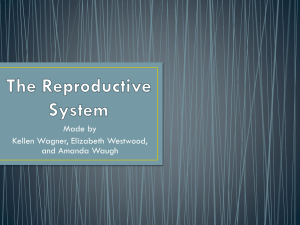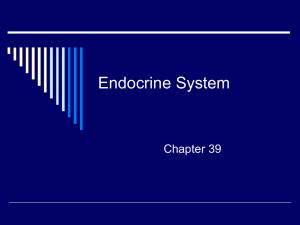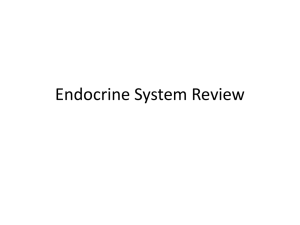Comparative Vertebrate Physiology
advertisement
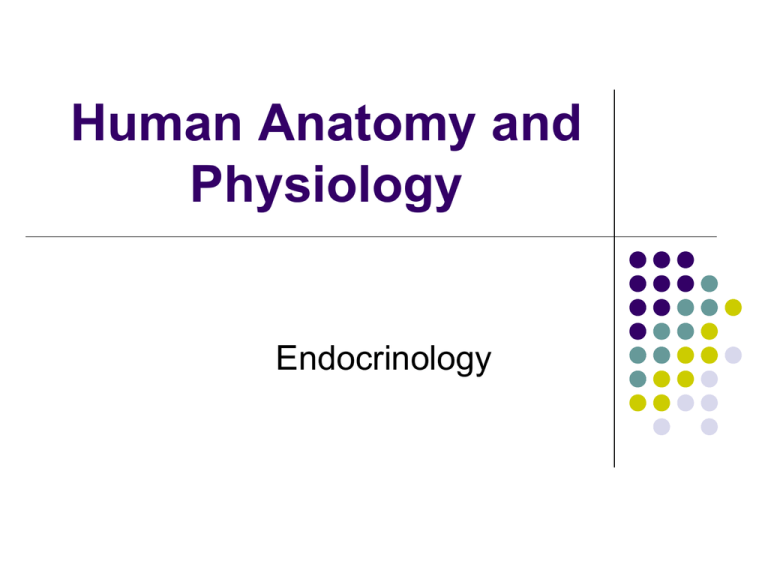
Human Anatomy and Physiology Endocrinology Overview Nervous system electrochemical impulses regulate muscles and glands quick response Endocrine system influences metabolism via chemical messages prolonged response Endocrine versus exocrine glands Endocrine glands Major glands Other glands Pituitary, thyroid, parathyroid, adrenal, pineal and thymus glands Pancreas, gonads Organs/tissues producing hormones Adipose tissue, intestine, stomach, kidneys, heart Hormones Steroidal Gonads, adrenal glands Amino acid based Works by a secondary messenger system Cyclic AMP : cAMP signaling mechanism PIP-Calcium signaling mechanism cAMP components Receptor, G protein, adenylate cyclase, cAMP, protein kinase Cyclic AMP signaling Cyclic AMP signaling Steps First messenger GDP displaced by GTP Activation of G-protein Activation of adenylate cyclase Hydrolysis of GTP to GDP Inactivation of G-protein Second messenger cAMP from ATP Activation of protein kinase Activation of metabolism PIP calcium signaling PIP calcium signaling Steps First messenger GDP displaced by GTP Activation of G-protein Activation of phospholipase Hydrolysis of GTP to GDP Inactivation of G-protein Phospholipase splits PIP2 into DAG and IP3 DAG and IP3 act as secondary messengers DAG activates protein kinases, IP3 triggers Ca++ release from ER Ca++ activates channels on plasma membrane or binds to calmodulin which activates metabolism Steroidal hormones Steroidal hormones Steps Diffuse into cell and enter nucleus Bind to receptors to form receptor complexes Complexes bind to DNA Production of mRNA mRNA + ribosomes make proteins Proteins include enzymes that stimulate metabolism Hormones Hormones travel in blood free or bound to protein carriers Blood hormone concentration decreases Degraded by target organs Removal by kidneys and liver Half-life (seconds to 30 min.) Hormone release Three major stimuli 1. Humoral Ca++ lowering causes PTH release 2. Neural SNS stimulates adrenal gland to release epinephrine 3. Hormonal (common) Hypothalamus releases hormones that cause pituitary to release other hormones (e.g. GnRH to FSH) Growth hormone Site of release Target organ All body organs especially bones and skeletal muscle Stimulation Anterior pituitary Primarily in adolescence, low levels of GH Feedback mechanism High levels of GH, hyperglycemia, obesity Thyroid hormone precursors Hypothermia TRH TSH T3 & T4 Increase in metabolism & body temperature Thyroid hormone Stimulation Falling levels of T3 (triiodothyronine) and T4 (thyroxine). TH raise BMR and heat production Feedback mechanism Increase in BMR and body heat (i.e., exercise) Parathyroid hormone Site of release Target organ Bone, intestine, kidneys Stimulation Parathyroid glands Falling Ca++ blood levels Feedback mechanism Increase in Ca++ blood levels Parathyroid hormone Ca++ needed for nerve impulses, muscle contraction and blood clotting Adrenocorticotropic hormone Site of release Target organ Adrenal cortex (glucocorticoids) Stimulation Anterior pituitary Stress (i.e., fever, hypoglycemia) cortisol Feedback mechanism Increase levels of blood glucocorticoids Adrenal gland hormones Mineralocorticoids (aldosterone) Site of release Target organ Kidneys Stimulation Adrenal cortex Decrease in blood volume, pressure, Na+ level Feedback mechanism Increase in blood volume, pressure, Na+ level Adrenal gland hormones Epinephrine and norepinephrine Site of release Target organ Heart, vasculature, bronchioles Stimulation Adrenal medulla Sympathetic nervous system (SNS) Feedback mechanism None. SNS stimulation decreases when needed Pancreatic hormones Insulin and glucagon Meal ( plasma glucose) Starvation ( plasma glucose) insulin from pancreas glucose uptake into cells plasma glucose glucagon glycogen from (skeletal plasma pancreas muscle, liver) glucose converted to glucose Other hormones Renal Arginine vasopressin (antidiuretic hormone - ADH) Reproduction Follicle-stimulating hormone (FSH) Luteinizing hormone (LH) Oxytocin
